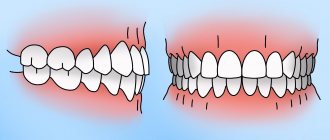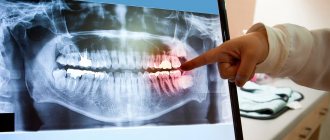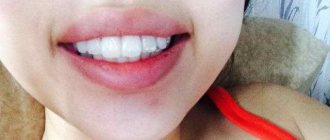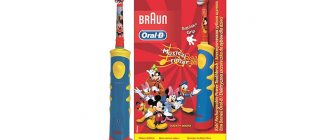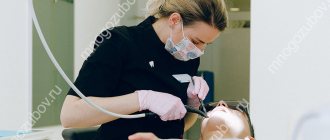Defects in the development of the jaw are a common phenomenon, occurring in nine cases out of ten. Often, deviations do not cause significant discomfort to patients, since they do not affect the aesthetics and functionality of the teeth, being limited to slight unevenness in the position of individual units of the row. However, there are also pronounced anomalies in which the closure of the upper and lower jaws is noticeably impaired and worsens not only the appearance, but also the general condition of the apparatus. One of the variants of such manifestations, included in the orthodontic classification, is a deep bite - what it is, what it threatens, what forms and signs it has, and how to correct the situation, we will understand in this article.
What is a deep bite?
People strived for a perfect smile back in ancient times, evidence of this is found in mummies from Ancient Egypt, which had ropes obtained from animal intestines entwined around their teeth.
They played the role of modern dental wires for braces. Now it is much easier to correct a deep bite. To achieve faster and more effective results, you need to start treatment from childhood. A deep bite is an anomaly that manifests itself in the form of overlap of the lower dentition with the upper one. The defect can be diagnosed when there is an overlap of more than 1/3 of the height of the crowns. The “lucky” one with a deep bite experiences discomfort while chewing food, speech impediments, and injuries to the gums and palate.
Treatment methods in adults
In adults, correction of deep bites is carried out using braces of any type. If the patient is unwilling or unable to wear an orthodontic structure, the patient can have veneers installed, which only cosmetically eliminate the defect.
Also, prosthetics using implantation is considered as an alternative, but expensive method. This procedure has a lot of contraindications, but effectively eliminates abnormal bite development.
Duration
The longest method is correction using braces . To obtain visible results, the patient will have to wear braces for about 6 months .
2 to 3 years to achieve final correction .
Retention period
After removing the system, in order to consolidate the effect obtained, it is necessary to use retainers for as long as the braces are worn.
For this purpose, two types of retainers are used:
- Individual mouthguards of removable type.
- Fixed arc , fixed to the problem area using special glue.
Causes of deep bite
Such an unpleasant phenomenon as a problem bite can appear both in childhood and in older age. In dentistry, there are several reasons that can lead to the development of pathology:
- birth defects associated with facial deformation;
- genetic inheritance of the specific structure of the dental system;
- improper dental prosthetics;
- delay in prosthetics.
Also, the causes of a deep, incorrectly formed bite can be constant finger sucking and lip biting. Even a pacifier can lead to the development of occlusion. The pathology does not go away on its own, but fortunately orthodontics is now very well developed, making it possible to effectively eliminate the manifestations of deep bite.
Surgical method
This method is used when others do not give results and the bite needs to be corrected in a short time. Surgery is used in very severe cases.
This method allows you to very noticeably transform a person’s face. The patient's external contour is transformed and becomes more attractive.
Surgical intervention is used:
- with an open bite in the area of the front teeth;
- with irregularities in the shape of the chin;
- in case of violation of facial symmetry as a result of an accident;
- with a deep bite, which appeared as a result of inheritance from parents.
The surgical operation is complex and difficult to perform, and expensive.
Classification of deep bite
According to the nature of origin, a deep bite can be:
- Primary – develops for reasons of irregular structure in the facial skeleton and dentition. The anomaly is most often represented by a deep blocking bite, which is manifested by limitation of jaw movements other than closing and opening. This pathological occlusion comes in two forms: dentoalveolar and skeletal deep bite.
- Secondary. The main reason for the formation of such a bite is due to previous diseases of the dental system. This could be periodontal disease, tooth loss, etc.
There is also a classification of deep bite according to the type of interaction of the lateral dentition:
- Distal - with this form of bite, the upper row of teeth overlaps the lower row by the length of the crown. The pathology is characterized by an underdeveloped lower jaw, a slightly sloping chin, a shortened face, and exposure of the crowns to the neck when smiling.
- Neutral - with such a bite, there are no pronounced defects in the skeletal structure of the face, its lower part is slightly shortened, and the chin is of a normal shape.
The stages of development of deep bite are divided into initial, progressive and traumatic.
Prices for bite correction
Orthodontic correction using a brace system.
Indirect fixation of one jaw. 5,000 rub.
Orthodontic correction using a brace system. Inspection and activation of the bracket system.
3,000 rub.
Orthodontic correction using a brace system. Re-fixation of the 1st bracket.
1,500 rub.
Orthodontic correction using a brace system. Fixation of the 1st bracket.
2,000 rub.
Orthodontic correction using braces on two jaws, 1st degree of complexity
103,000 rub.
Orthodontic correction using braces on two jaws, 1st degree of complexity, initial stage
50,000 rub.
Orthodontic correction using braces on two jaws, 1st degree of complexity, final stage
15,000 rub.
Orthodontic correction using braces on two jaws, 1st degree of complexity, scheduled visits
35,000 rub.
Orthodontic correction using braces on two jaws, 2nd degree of complexity
118,000 rub.
Orthodontic correction using braces on two jaws, 2nd degree of complexity, initial stage
50,000 rub.
Orthodontic correction using braces on two jaws, 2nd degree of complexity, final stage
15,000 rub.
Orthodontic correction using braces on two jaws, 2nd degree of complexity, scheduled visits
51,000 rub.
Orthodontic correction using braces on two jaws, 3rd degree of complexity
133,000 rub.
Orthodontic correction using braces on two jaws, 3rd degree of complexity, initial stage
50,000 rub.
Orthodontic correction using braces on two jaws, 3rd degree of complexity, final stage
15,000 rub.
Orthodontic correction using braces on two jaws, 3rd degree of complexity, scheduled visits
67,000 rub.
Orthodontic correction using braces on two jaws, 4th degree of complexity
147,000 rub.
Orthodontic correction using braces on two jaws, 4th degree of complexity, initial stage
50,000 rub.
Orthodontic correction using braces on two jaws, 4th degree of complexity, final stage
15,000 rub.
Orthodontic correction using braces on two jaws, 4th degree of complexity, scheduled visits
83,000 rub.
Orthodontic correction using braces on one jaw, 1st degree of complexity
48,000 rub.
Orthodontic correction using braces on one jaw, 1st degree of complexity, initial stage
25,000 rub.
Orthodontic correction using braces on one jaw, 1st degree of complexity, final stage
7,500 rub.
Orthodontic correction using braces on one jaw, 1st degree of complexity, scheduled visits
17,500 rub.
Orthodontic correction using braces on one jaw, 2nd degree of complexity
59,000 rub.
Orthodontic correction using braces on one jaw, 2nd degree of complexity, initial stage
25,000 rub.
Orthodontic correction using braces on one jaw, 2nd degree of complexity, final stage
7,500 rub.
Orthodontic correction using braces on one jaw, 2nd degree of complexity, scheduled visits
RUB 25,500
Orthodontic correction using braces on one jaw, 3rd degree of complexity
64,000 rub.
Orthodontic correction using braces on one jaw, 3rd degree of complexity, initial stage
25,000 rub.
Orthodontic correction using braces on one jaw, 3rd degree of complexity, final stage
7,500 rub.
Orthodontic correction using braces on one jaw, 3rd degree of complexity, scheduled visits
RUB 30,500
Orthodontic correction using braces on one jaw, 4th degree of complexity
74,000 rub.
Orthodontic correction using braces on one jaw, 4th degree of complexity, initial stage
25,000 rub.
Orthodontic correction using braces on one jaw, 4th degree of complexity, final stage
7,500 rub.
Orthodontic correction using braces on one jaw, 4th degree of complexity, scheduled visits
RUB 41,500
Orthodontic correction using braces. Treatment with partial braces.
20,000 rub.
Deep bite in children
The cause of deep occlusion can be birth trauma, a long period of sucking a pacifier or finger, late loss of baby teeth, calcium deficiency, or trauma to the dental system. In 15% of schoolchildren, a distal deep bite is diagnosed - the upper jaw is strongly pushed forward. It can develop against the background of impaired nasal breathing, adenoids, enlarged tonsils, frequent colds, and rickets. Also, improper formation of the bite can be caused by the removal of teeth at an early age, or the habit of propping up the chin.
Etiology
Factors predisposing to the formation of a deep bite are hidden in the prenatal period. Hereditary predisposition, infectious diseases suffered during pregnancy, mechanical injuries and chronic diseases (for example, anemia) can cause such negative consequences.
Causes of deep bite:
- Prenatal: toxicosis,
- intrauterine infectious diseases,
- multiple pregnancy,
- reduced oxygen content in the body.
- protein-energy malnutrition,
- late teething,
Symptoms of deep bite
Externally, improper closure of teeth is manifested by shortening of the lower third of the face, the formation of a pronounced supramental fold, and turning of the lower lip outward. Among the oral signs:
- overlap of the lower frontal dentition with the upper one by the size of the crown;
- inflammatory process of the mucous membranes of the mouth;
- rapid erosion of tooth enamel, which leads to the development of caries;
- excessive overhang of the upper jaw over the lower jaw;
- decrease in the depth of the vestibule of the oral cavity.
Also, with malocclusion, secondary symptoms appear that develop against the background of the primary ones: problems with diction, breathing, deformation of the cranial vault, pain while chewing food.
Diagnosis of deep bite
Occlusion can be determined by external signs, but not all forms of improper closure of teeth are pronounced, so additional diagnostics are required. The specialist examines the patient’s medical history and conducts a visual examination of the oral cavity. The following activities can be carried out:
- taking an impression with alginate mass, followed by making diagnostic models and measuring them;
- photo of the face in profile and front;
- X-ray examinations;
- measurement of dental arches, apical base;
- performing an occludogram.
When making a diagnosis, data obtained from the results of electromyography, orthopantomography and teleradiography play an important role.
Consequences of deep bite
Elimination of deep occlusion is necessary not only to achieve an aesthetic result, but also to treat phenomena that bring a lot of discomfort in everyday life. Teeth that do not fit properly can cause the development of speech defects, facial asymmetry, and various aesthetic deviations. Besides:
- a large load on the front teeth provokes increased sensitivity and rapid abrasion of the enamel, which leads to caries;
- Loose teeth and frequent inflammatory processes in the gums appear against the background of their constant injury.
The pathology also leads to a decrease in the height of the bite, headaches, tooth wear and subsequent loss of tone of the masticatory muscles.
Treatment of deep bite
For deep bites in adults, braces are usually used. A very interesting fact is that for the manufacture of certain types of braces, nickel-titanium is used - a material created by NASA for use in space. Clear aligners can also be used, which are more aesthetically pleasing. In addition, they are convenient, as they can be removed when eating or brushing your teeth. It takes at least 12-14 months to correct improper closure. The effectiveness of treatment and its duration depend on the degree of pathology and the correct choice of orthodontic design. To achieve a good result, it is important for the patient to comply with the rules established by the treating dentist. Treatment of deep bite in children is simpler, since the dentition is not yet fully formed; the course of occlusion can be influenced by the following methods:
- the child needs to be accustomed to solid food in order to create optimal stress on the teeth;
- it is important to cure dental caries;
- during the change of baby teeth, plates or other orthodontic structures (Frenkel, Bruckle, trainers) are installed on molars;
- At the age of 12 years, vestibular and lingual braces can be installed.
The iOrtho network of clinics selects the most effective treatment method taking into account the specific situation. We provide high-quality services and a modern treatment method using Invisalign aligners. Book your consultation now to enjoy a beautiful smile in just a few months.
Treatment errors
When turning to inexperienced specialists, you may be faced with the selection of the wrong treatment method. If there is a mistake in choosing devices such as occlusal pads, crowns, mouthguards for children, their large molars and incisors may become separated. This leads to rapid erasure of the cusps on the antagonist teeth located in the lateral row. In the anterior part, on the contrary, there is a sharp separation of the teeth and their protrusion forward, worsening the incisal overlap.
Deep bites in adults and teenagers can only be completely corrected if there is enough space underneath. Once the jaw has formed, some teeth will need to be removed to gain sufficient space. You also need to take into account the fact that when removing tooth protrusion in the anterior part of the dentition, the incisal overlap increases.
The effectiveness of treatment using the Herbst apparatus
Deep overbites are often corrected using the Herbstat appliance, a permanent orthodontic appliance. To correct the occlusion, it must be worn for at least 3-12 months. Its main task is to restrain the growth of the upper jaw, correct the lower jaw, and rebuild the functioning of the muscles of the dental system. The choice of this treatment method allows you to accurately predict the result and achieve it in a short time. The device does not interfere with eating or talking.
Symptoms and signs
In patients with this type of malocclusion, the periodontal tissues are most often the first to suffer, which is expressed in loose teeth, gingivitis (inflammation of the gums), as well as chronic trauma to the oral mucosa by teeth.
With a deep bite, facial signs are usually characterized by an unsightly lip position and a somewhat shortened lower part of the face. Patients with this anomaly may have difficulty chewing and biting food. In addition, there may be an increased load on the teeth in the front row and some speech disorders (“speech through teeth”).
Also, a deep traumatic bite can cause a decrease in the oral cavity, which, in turn, contributes to the development of improper breathing and swallowing. At the same time, some patients with this diagnosis also experience increased tooth wear, leading to changes in the tone of the muscles responsible for chewing, and as a result, to disorders in the temporomandibular joint. This consequence of deep incisal overlap is expressed by the fact that patients experience clicking and crunching in the joint, slight pain during movements of the lower jaw, and sometimes frequent headaches.
Forecast and prevention of deep bite
The prognosis of a deep pathological bite when choosing the right treatment method is always positive. It is possible to correct incorrect teeth closure even in adulthood, but in order for the result to be of better quality, treatment must begin in the first stages of its development. Prevention is also important, it is necessary to control the loss of baby teeth and the correct growth of molars, monitor the position of the child’s head during sleep, protect him from bad oral habits, in particular prolonged sucking of a pacifier and thumb, it is important to promptly treat ENT diseases and other pathologies that can cause the development of a deep bite.
Why does a bite defect form?
The formation of occlusion is influenced by genetic predisposition, intrauterine development and factors that can occur after childbirth.
Specifying the factors, the following causes of malocclusion can be identified:
- Mother's diseases. A child may inherit an anomaly due to the fact that his mother is sick with viral diseases, metabolic disorders, endocrine diseases and anemia.
- The course of pregnancy with pathology.
- Improper intrauterine development of the fetus.
- Bad habits such as prolonged thumb and pacifier sucking.
- Defects (acquired, congenital) of the musculoskeletal system.
- Impaired functions of sucking, speech, swallowing and breathing.
- Diseases of the digestive system.
- Diseases of the ear, nose and throat.
- Osteomyelitis of the jaw.
- Caries of lateral teeth.
- Too early loss of primary first molars or lateral teeth.
- Teething with delays.
- Jaw injuries.
- Change of primary permanent teeth with a time delay.
- Congenital anomalies (disorders of the facial skeleton).
Considering the frequency of occurrence of deep bite, we can say that it accounts for approximately 20% of all tooth curvatures.
There are secondary reasons for the appearance of a deep bite: incorrect posture, mouth breathing, frequent lip biting, muscle tone greater than normal, infantile swallowing.
